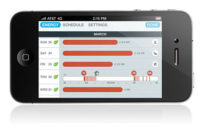There are many elements to a BAS. Of course, the ability to control systems through direct digital control (DDC) is always a require-ment, but ideally, we expect these systems to be much more. For example, most systems are expected to provide energy management (EMS) (often through basic strategies such as scheduling equipment and systems to run when the building is occupied), and to keep the building at safe conditions when unoccupied.
As we start to see the convergence between traditional building systems and IT systems, the expectation is that these do much more. It starts with fairly basic functions such as alarming and trending. We are in the process of starting up a new web-enabled system and almost every point is continuously trended. This seemed like an unreasonable request even a few years ago when we had a system with very limited resources. Today, however, most new systems have access to a server that can easily store large amounts of data. The ability to view and analyze trend data, even in their most raw form, turns out to be an invaluable tool to analyze building performance. We also see systems that are readily integrated to various systems. For example, we can now easily see the energy usage from a fan (in Kw, Amps and KWH) simply by connecting the VFD to the BAS.
VISUALIZING DATA
The next step in this progression is to include a series of tools that can assist in visualizing, displaying, and analyzing data related to the energy use and operations of a commercial building. There are a whole series of functions related to this set of tasks. At one end of the spectrum is the normalization of data and displaying it for building occupants on a kiosk or webpage. This is often called a dashboard. At the other end of the spectrum are tools (or services) that do extensive analysis and provide “continuous commissioning.” In between are what we call Energy Information Systems (EIS) that bring in data, normalize data, and provide tools to analyze and present it to a wide variety of users.
Today, we are seeing the early stages of a new industry focused on building and energy analytics. We recently did a study for a client on these systems, and without much effort, we found close to 50 suppliers in the market. Groups are now doing research and development work on creating standards and definitions for EIS. For example, there is work going on in the Open Source Community (Project Haystack) as well as research under way at the Department of Energy to develop an open EIS platform and definition of standard algorithms. Solutions are being offered to building owners in the form of products, web services, and consulting arrangements.
While the idea of EIS and continuous commissioning has been around for years, I think it is reaching a tipping point where it is going to move from the use by early adopters into much broader usage. We are already seeing the major control companies introducing products in this space and more and more events and development occurring. The focus is clearly changing from seeing the BAS as being an enhanced temperature control system to becoming a working part of an EIS that may be used for the successful operation of a high-performance building.
Ehrlich has worked on a series of ASHRAE projects including the BACnet committee and “Guideline 13 – Specifying DDC Controls.” The formation of the Building Intelligence Group allowed him to provide assistance to owners with the planning, design, and development of Intelligent Building Sys-tems. Email him at paul@buildingintelligencegroup.com.
Building Intelligence Group provides services for clients worldwide including leading universities, corporations, and developers. More information can be found at www.buildingintelligencegroup.com.






